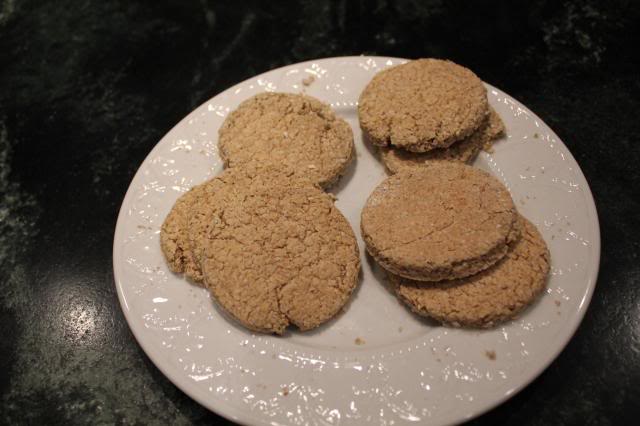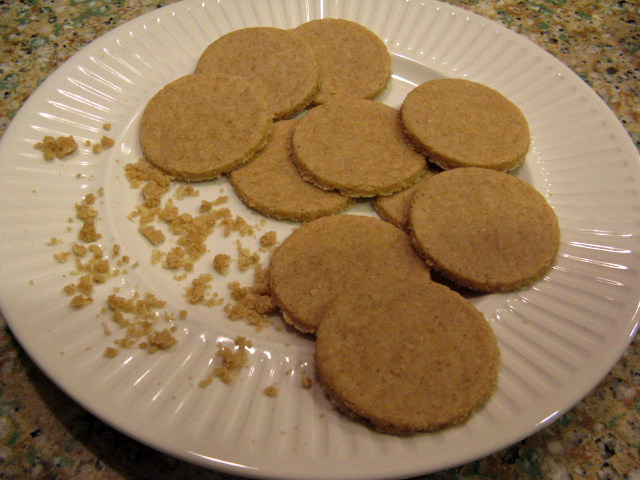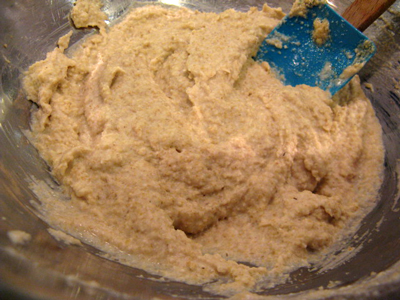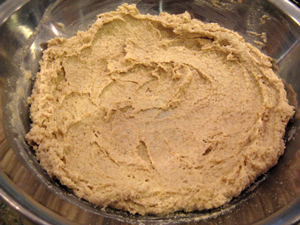
Scottish Oat Cakes, Round 1
I've begun fiddling with Scottish Oat Cakes. They are a bit of a departure from my usual yeasted bread baking. What makes it tricky is that I really don't know what my target is; I suppose I may have to wait for our trip to Scotland and Ireland this summer to see whether I'm on the right track.
There are probably several thousand "traditional" Scottish oat cakes recipes. That doesn't include all the Canadian variations on the theme, nor the more pancake-like versions. At it's simplest, an oatcake is a mixture of oatmeal (ground, not flaked), water, and fat that is baked on a baking stone or "girdle" over an open fire. It is sturdy, hearty fare that can underpin savory or sweet foods. Having sampled them, I wonder if this was the inspiration for Tolkien's lembas, the Elfen waybread that was so sustaining. Literary musings aside, the oatcake is the precursor to the scone, which was also orginally baked on a girdle (I'm going to switch to the American "griddle" for the rest of this post). Nowadays there are recipes for both oatcakes and scones that are oven-baked instead of griddled.
Here in the States, the stone-ground variety of oatmeal is very hard to come by and ridiculously expensive. We are very accustomed to calling rolled oats "oatmeal". I chose to exercise two different options for this first go-around. First, I ground some hulled oats, using the KitchenAide grain mill attachment. (My wife had found one back in February at a kitchen shop that was going out of business for a price that was substantially less than list price.) Second, I used our food processor to grind some rolled oats into a faux meal. I thought that would give me a good idea of both the handling and flavor characteristics of each.
The recipe I worked from is as follows:
- 1 cup medium oatmeal
- 2 pinches baking soda
- Pinch of salt
- 2 teaspoons melted fat (bacon fat, if available)
- 3/4 tablespoon hot water
- Additional oatmeal for rolling
Let me say right up front that I believe there is a typographical error in the formula. It seems to me that the 3/4 tablespoon of water should be 3-4 tablespoons of water. I know that I had to use substantially more than the recipe quantity to achieve a workable consistency. The process is simple: combine the dry ingredients, then add the fat and water and mix until a stiff paste results. You want to work quickly with this so that the dough doesn't cool significantly, which makes handling more difficult. Roll the dough to approximately 1/4 inch thickness on an oatmeal-covered surface. Cut into 3-inch rounds with a biscuit cutter. Re-roll the scraps and repeat until all dough is used. Cook on a griddle over medium heat, 3 minutes per side. Each batch made 6 oatcakes.
Here's the finished product, ground rolled oat version on the left, oatmeal version on the right:

As prepared, the cakes were soft (in an authoritative way), rather than crisp. They want plenty of liquid to wash them down; a large bite tends to stick to the teeth while chewing. The oatmeal version was a hands-down winner over the rolled oats version in the flavor category. That may not be entirely fair, since I was already won over by the fragrance of the freshly-ground oatmeal as it came out of the mill. I've tried them with fruit preserves and they are delicious. I haven't yet tried them with savory accompaniments but can see how they would play very nicely with cheese or smoked meats. It's difficult to say what, if anything, the baking powder contributed. There's no acid component for it to react with, so these are not light little puffs. They are rib-sticking food that can fuel some hard work.
If anyone with first-hand experience with oatcakes wants to weigh in, I'd love to hear your input. That help me gauge what I have so far and what might need to change.
Paul


Comments
I
Hi Paul! I can't say I have ever made oatcakes.
I do love the McCann's Steel Cut Imported Irish Oatmeal. McCann's does have a website with recipes. I believe there is an Irish Oatcake recipe there.
Steel cut oats from Ireland are some of the finest oats in the world. The outer husk is removed from the oat kernel and then cut into pieces using steel discs. That's all no rolling or steaming. It's a distinct flavor and texture that is unprocessed. 100% whole grain oats. I think they would make delicious oatcakes.
Sylvia
But I don't see a way to get the steel cut oats to bind together. There needs to be some amount of fines I the meal, otherwise it will crumble instead of holding together. Even with an overnight soak, the steel cut oats are a long way from pliable. It might be worth a try, just to see what happens.
We do en joy the steel cut / pinhead / Irish / Scotch oats as a breakfast cereal.
Paul
So many different recipe versions! Cracker or grilled.
These would have no problem being pliable. I think a plus too. Hot off the grill with your choice of fillings.
There is a video on you tube showing a grilled very popular oat cake. 'All Hail the Potteries Oatcake' you tube video. Simple ingredients and wonderful fillings. I can see why the locals love them.
The recipe at McCann's just shows boiling water added. The steel cut oats are hard and I would have to cook them or soak them until they are more pliable.
Sylvia
whir up steel cut oats in the coffee mill and then soak them, usually in milk, if going into baked goods. With the recipe of Scottish origin and having B soda in it, one would think the liquid would be buttermilk? But, this had to be food for travel and buttermilk might not have been available on the road?
Another option, since these had to be made before BS was invented, is to convert them back to their original SD version to see what they really tasted like in the old days - even before we were born - but I would stll leave the BS and butternilk in them too :-)
My apprentice would also like to see version with some brown sugar in it, pumpkin pie spices and dried fruit since that is her favorite oatmeal variety - but that might be pretty close to a grnola power bar!
You have an interesting experiment going on with lots of possibilities Paul.
had no leavening, whatsoever. Clayton references a "sour skon" from the Orkneys (I think) that calls for soaking oatmeal in buttermilk for several days. It also features caraway seeds.
Like you said, lots of possibilities.
Your apprentice must be a big fan of oatmeal-raisin cookies.
Paul
When I researched it, I discovered there was the Nova Scotia type that has much more sweetener and fat (more cookie-like) and is often dipped halfway in chocolate! Then there was the UK version that was definitely not sweet and more oat-ey.
http://www.thefreshloaf.com/node/32861/so-are-oatcakes-cracker-or-cookie-tell-me-how-you-eat-them
They did have some pastry flour as a binder and at the end of the post, there are some pictures provided of modern commercial oatcakes that people enjoyed. They are definitely not oreos and as you continue to eat them (over days) they do grow on you! It is a true commfort food and very hearty. I agree that a LOT of liquid is called for.
My oats were a little older and, while not too old, you can definitely tell the difference in flavor. I added more sugar than called for so mine were sweeter but not cookie sweet at all.
Enjoy and when you get to Ireland/Scottland, let us know!!
I looked at some of the Nova Scotia variants, too, and suspect that they are far sweeter than would have been the norm when these were staple foods.
Their blandness is what makes them so versatile. A smear of jam and you can tell yourself that you are eating dessert. A few kippers and some cheese and you have a hearty lunch. Not sure how they would play with haggis (does anything?).
You will probaby see a post or two from me about Scotland and Ireland.
Paul
Paul,
I suggest Elizabeth David's well-written English Bread for this and other subjects. There is an Americanized edition. I suspect the soda is an error. Her various oatcake recipes use fine meal.
Thanks for the tip, charbono.
Paul
Hi Paul,

We haven't had oatcakes for a long time - thanks for your post & charbono's comment - prompting me to give Gracie McDermot's oatcakes a try (from Ms. David's book).
Enjoyed reading in Ms. David's book how oatcakes were known as "the 'Moon and Stars', the round oatcake...being the moon and the...crumbs the stars". I see that in your photo :^)
My try is more like a cracker than a cake:
After mixing, the dough was left uncovered to dry (8 hours) before rolling thin (9"x9" pan), cutting round and baking (1.5 hours at 265F convection). These were the weights I used (the recipe in the book was a little heavier on salt so I cut back to 1.2%):
1g salt dissolved in 66g boiling water, 10g fat added, stirred to melt; poured over 83g finely-ground oat flour, stirred to combine.
The dough had a very wet texture at this point. Let the dough rest uncovered to dry, until firm enough to press or roll out.
I'll try these again, but might double the quantities for the pan size I was using and adjust baking time, to get thicker oatcakes that look more the ones you made. Then I might be able to properly 'griddle' them like you did!
:^) breadsong
Interesting that this verson calls for oat flour rather than oatmeal. And boiling, instead of hot, water. I'm not sure that I would want to wait eight hours for such a small quantity of dough to dry. Do you suppose that it is the gelatinization caused by the boiling water that makes it so sticky initially?
I like the moon and stars notion.
Paul
Hi Paul,

In the past when I've scalded flour, the flour/water mixture 'seizes up' and becomes firm instantly (provided there is sufficient water for the scald).
Not so, with this mix; the consistency was more like a thick batter:
It didn't take long for the oat flour to start absorbing the water (5 minutes later):
After drying:
I wonder if oats take longer than wheat, or rye, to absorb water? Allowing the drying time made this dough really easy to roll out.
I wonder, too, how much of an effect water temperature might have had - it wouldn't have been at absolute boiling, after stirring for a bit to dissolve salt, then stirring a quantity of room temperature fat, to melt - maybe that affected the initial water uptake leaving a looser mixture at the start?
I hope you enjoy your experiments with oatcakes, hope you have a wonderful trip to Scotland, and glad you liked the 'moon and stars'.
:^) breadsong
Those are some interesting questions, too. The recipe I used simply said "hot" water, without specifying a temperature. Not knowing any better, I used hot tap water, probably less than 120F. Definitely no gelatinization going on at that temperature!
Flour vs. meal vs. flakes vs. steel cut oats, a wide range of water temperatures, different fats, soda or no soda; so many variables!
We are eager for the trip. Thank you for your enthusiasm.
Paul
Paul,
You don't have to wait for the summer. Nairn's oatcakes from Scotland can be found at Whole Foods or on Amazon. They are fairly thin and crunchy and a little on the salty side, and are good with cheese, for example. There are some thicker and softer brands out there, but I think of the Nairn's style as the standard.
I have only tried making them once (so far) but Bob's Red Mill Scottish Oatmeal worked pretty well. If I remember correctly, there is a recipe for oatcakes on the back.
Colin
Those will require sampling.
Bob's Scottish oatmeal is about the only one that I have seen on-line and it does seem very much like what I have read about on Scottish sites.
Paul
Perhaps the secret is to use real pin oats?
A while back when I was pining for a bit o' haggis in the morning, I discovered the following site:
http://www.caledoniankitchen.com/oatcakes-and-crisps.php
perhaps you can order up the oatcake sampler and refine your goals.
Another thought is that leaf lard might add to a better texture and be more typical of that sort of cuisine.
Other than that, I spent my time in Scotland seeking out liquid sustenance and for some reason cannot remember oatcakes clearly.
But basically just wanted to drop in to express how envious I am of your going to Scotland. Hope you are going to the North - which I found to be breath taking. Out of the many places I have been - so many of which are wondrous - only Scotland and the Vaucluse (opposites in so many ways) have really gotten under my skin. Have fun! (And seriously - I developed quite a taste for haggis. The cook where I was working would boil us up a big tasty lunch of haggis, neeps, and taties every Friday. Delicious. Everything goes with haggis - especially a wee dram of the local libation!)
Others have suggested pin oats, aka steel cut oats, too. In the interests of a thorough investigation, I should probably see whether I can locate a recipe that calls for them and give it a try.
Lard would probably be a better fit than butter. Given the provenance of the food, mutton tallow or beef suet may also have made appearances in older days. I do like butter, though.
So a PA Dutch girl wound up with a liking for haggis, did she? Maybe the scrapple was training of sorts? Or maybe it was the drams. Enough of those could lead to haggis. Or vice versa.
We are very much looking forward to this trip. It's one of those packaged deals that doesn't allow for much time off the beaten path. However, it could serve very well as an introduction for another, more in-depth trip.
Paul
I tend to use blends of these in things like piecrust, cookies, biscuits and pastries. There is benefit by using a pure fat in terms of texture and we all like the taste of butter.
Oh man - scrapple. Now there's some good stuff with unpromising origins. I really think that my training in overlooking "which part of the animal did this come from" and my long months in Malaysia where I ate anything that I didn't know what it was made me fearless when faced down with the Chieftan o' the Pudding race. I found it delicious from the start (and without the drams although a wee dram poured ON the haggis does enrich its flavor). If you are in Glasgow - and your tour takes you to the Willows Tea room - the haggis is most excellent there. (as is the architecture, so if you are in Glasgow - your tour operator should get you near there...)
Have fun with the oatcakes and beyond!
Pat
Leaf lard would work very well. I simply haven't located a source locally; not that I've been looking very hard. Maybe McGonigle's or some other local shrine for carnivores could get some for me to render. Butter, on the other hand, is easily available.
Scrapple, like headcheese, is an acquired taste. I like both, so it will be interesting to see how haggis goes down. We will be in Glasgow, so I'll put Willows Tea Room on the list of places to visit, if possible.
Paul
There're various ways of making oatcakes, like which oatmeal to use (or blend of two kinds), whether you mix in some wheat flour, what fat/oil to use, etc, etc. There're regional variations, too, like Scottish, Irish, Staffordshire, etc. Perhaps there're as many recipes for oatkaces as there're cooks. THE BEST-EVER oatcake I'd had was at a small B & B in Scottish highland made by the owner's wife who was the excellent wife. Wish I'd asked for the recipe......
If you want to taste 'genuine' oatcakes before you go to Scotland, Nairn someone suggested above is one of the major oatcake maker in UK, perhaps with the biggest share in oatcake market, so you can regard theirs as a sort of 'standard' oatcake, though I must say it looks and tastes distinctly factory-made.
Here's some recipes and a few writings on oatcakes that I've found interesting.
http://www.telegraph.co.uk/foodanddrink/recipes/4223510/Oatcakes-recipe.html
http://www.guardian.co.uk/lifeandstyle/2007/oct/06/foodanddrink.recipes1
http://www.bbc.co.uk/food/recipes/oatcakes_74180
In my naivete, I had thought that oatcakes were, well, oatcakes. And I have since been learning just how many styles there are (which is another way of saying just how wrong I was).
My preference, now that I am beginning to understand the extent of my ignorance, is tilting in the direction of the biscuit-shaped, griddled (or, possibly, baked) version that produces either a firm or crisp cake. The fried mush versions (while no doubt tasty) don't enthuse me. Neither do the pancake/crumpet/pikelet members of the breed. If I want a bannock or scone style, then I'll make bannocks or scones. The firm-to-crisp biscuit-shaped versions are more conducive to hand-held foods and, it seems, play nicely with a wide range of other accompaniments.
As for specific ingredients, I haven't yet settled. Fresh-milled oatmeal is definitely tastier than rolled oats from a cardboard box. Steel-cut oats seem to feature in a lot of the fried mush oatcakes, or require some mechanical grinding which gets me back to milling my own. Still need to explore that avenue a bit further before declaring it a dead end, though.
Eventually I'll get to something and someone, somewhere in the world will say "Now that's a proper oatcake!" And then we'll both be run over by the adherents for the other types. ;-)
Thank you for the links.
Paul